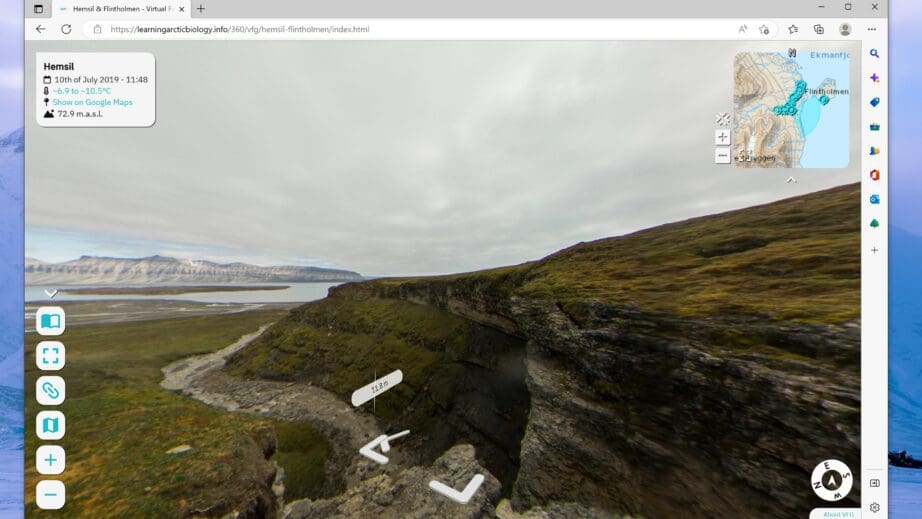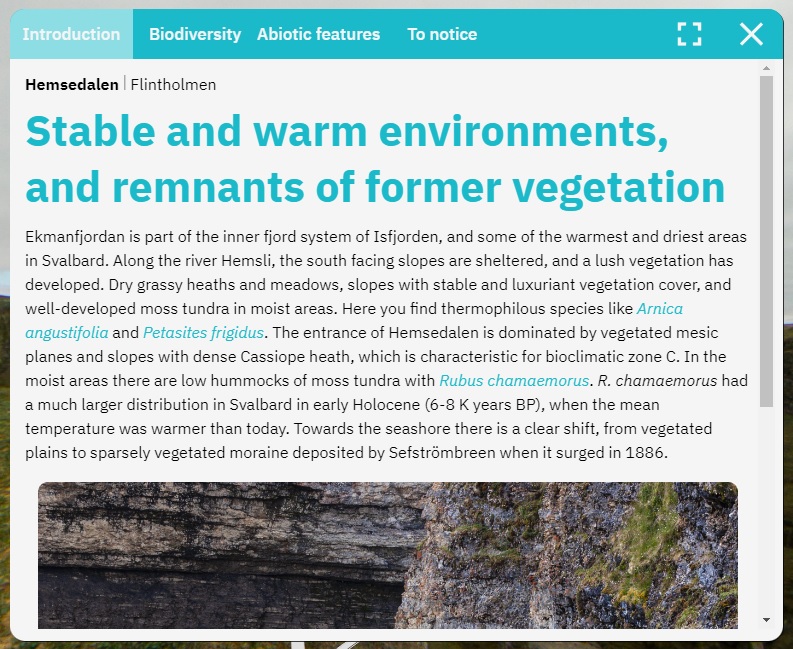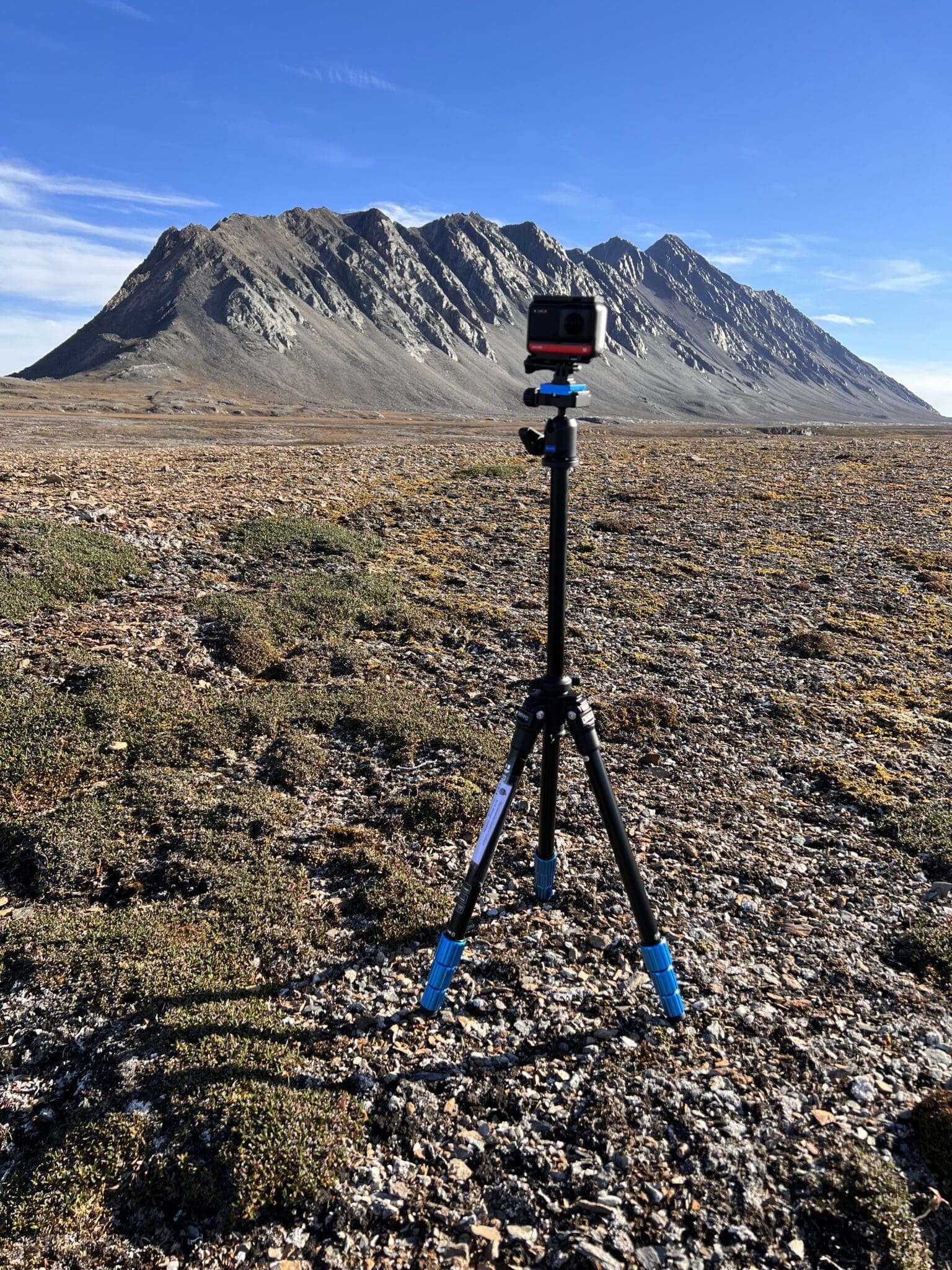360° Virtual Field Guides
FieldPass are trying to improve how students can learn about fieldwork and how practical skills and general competences achieved through fieldwork can be assessed. One way to achieve this is through the use of Virtual Field Guides (VFG's).
active

Screengrab of a Virtual Field Guide (VFG) from Hemsil, Svalbard.
About the project
Field teaching is an important component in many natural science courses with focus on hands-on learning experiences in the field and the possibility to integrate research in education. However, it is also a costly and a resource intensive activity and demands a high level of work effort from both students and teachers.
In order to improve student learning during fieldwork there is a great potential in utilizing digital tools for both preparation and recap of fieldwork. We have developed VFG’s that enable students to familiarize themselves with a field location in forehand. And use them to refresh knowledge after field and utilize them within teaching where students have to complete a task using the VFG’s.
How they work

The VFG’s functions similar to Google Street View in the way they are navigated, but we have added a lot of information about the environment one is in.
Each VFG is accompanied with a Field Handbook (Fig. 1). Which gives an introduction to the location (Introduction), an overview of the biological diversity expected in the area (Biodiversity), an overview of abiotic features that can be used to classify the area (Abiotic features), special things to take notice to (To notice). The Field Handbook also works as a navigation tool, directing the user to points of interests.
Exploring around a VFG, one will find “hotspots” (small icons) that can be clicked on to bring up more information.
There is also an emphasis to not have too much text, and link out to other good digital resources. Such as Learning Arctic Biology, Artsdatabanken, Svalbardflora and Geosvalbard.
Seasonal VFG
The Svalbard environment changes a lot depending on where you are on the archipelago. It’s not all the same. But there is also changes over time, throughout the seasons. From the short summers when the sun never sets, the wet autumns, and the dark and cold winters. Each one providing their own sets of challenges for living in the Arctic.
We wanted to capture these changes, and to achieve this we visited the same locations around Longyearbyen to capture 360° images. Once a month, for a season.
The VFG locations that features seasonal changes are from Bjørndalen, Endalen and upper Adventdalen.
These locations, with their close proximity to UNIS and Longyearbyen, are research hotspots and often used for smaller field excursions with students. Which adds to the value of having them.
Methods

VFG’s were created using 360° panorama images captured with a 360° camera (Fig. 2), such as Insta360 or GoPro action cameras. One can also use the panorama function present it most modern mobile phones, with a drone that supports capturing 360° images, or stich together photos taken with a normal camera.
The 360° images were then imported into a software dedicated to create virtual tours using normal panoramas and/or 360° panoramas. In our case, we used a software called Pano2VR, but Google and other companies offers similar tools. Though Pano2VR allows for the greatest flexibility and creative control in our experience, while still being user friendly.
The VFG’s can then simply be hosted online, enabling anyone possessing a computer to access them. It is also (with Pano2VR) possible to have the VFG’s offline, and with some extra optimization make them work well for smartphones and tables.
Video presentation
Publications
Outreach
- Eidesen, Pernille Bronken et al. (2022). Virtual tools and field teaching. Workshop, UNIS, GRID Arendal.
- Hjelle, Simen Salomonsen; Eidesen, Pernille Bronken (2022). How to create virtual field guides (VFGs). Workshop, UiO.
- Eidesen, Pernille Bronken; Hjelle, Simen Salomonsen (2022). Pedagogisk innovasjon ved bruk av digital teknologi: Virtuelle feltguider gir økt læringsutbytte i møte med virkeligheten. Seminar, Konferanse: Utdanningskvalitet og digital omstilling 2022, HKDIR.
- Eidesen, Pernille Bronken; Hjelle, Simen Salomonsen (2022). How to utilize virtual field guides in teaching. Workshop, UNIS.
- Eidesen, Pernille Bronken; Hjelle, Simen Salomonsen (2021). Virtuelle feltguider bygger bro mellom teori og praksis. Læringsfestivalen, NTNU. Talk.
- Hjelle, Simen Salomonsen; Eidesen, Pernille Bronken (2021). Creating 360° Virtual Field Guides to improve field learning. Learning Forum 2021, UNIS. Poster and workshop.
Development credits:
Developed by: Simen Salomonsen Hjelle
Project manager: Pernille Bronken Eidesen
Text: Pernille B. Eidesen, Simen S. Hjelle, Tina Dahl, Sine-Sara E. Astad
Primary species info sources: SvalbardFlora, Norwegian Polar Institute
Special thanks (No order): Tina Dahl, Sine-Sara E. Astad, Anna Miettinen, Aleksandra M. J. Waltila, Neha Chaudhary, Rebecca K. Donali, Marlena Wegner, Rafael K. Horota, Nil Rodes, Maria Dance, Simone Lang, Anne Bruls, Xenia Uffrecht, Hana Spickova
Funding by: HKDIR, Svalbard Environmental Protection Fund, The University Center in Svalbard
Copyright 360-Panoramas: Attribution-ShareAlike 4.0 International (CC BY-SA 4.0)
Icons: Feather Icon Set, Font Awesome
Maps: Leaflet, Map Topographic © Norwegian Polar Institute, Map Satellite © Esri, Maxar, Earthstar Geographics and the GIS User Community, Map Nautical © Kartverket
Software used: Pano2VR, Insta360 Studio, Adobe Photoshop
Cameras used: Insta360 X, Insta360 One R
A part of the project FieldPass.
External partners:
Anne Bjune (UiB) / Virtual Field Guides (UiB/bioCEED)
Jonathan Soulé (UiB) / Virtual Field Guides (UiB/bioCEED)